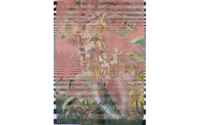A New Generation of Computer Plotting Arrives at Pace via Tyler Hobbs
Thousands of artists jumped into the NFT game when the crypto market was soaring in 2021, hoping that they could leverage this pivotal moment when digital art seemed to finally matter into an art world debut. Generative artist Tyler Hobbs is one of very few to have successfully made this transition, and he’s done so at one of the world’s top galleries, Pace.
His show on view now in New York is one of the rare exhibitions of its kind in a blue-chip mega like Pace. It’s the first time Pace has given a solo show to an artist engaged in a web3 project, and like some of the artists who make NFTs for Pace’s Verso program for digital art, Hobbs is not represented by the gallery. Yet his work is bringing them into the computer art space with a project that harkens back to the medium’s origins.
Now on view at the gallery’s New York space is “QQL: Analogs,” a series of 12 paintings Hobbs made using generative code and a computer plotter. The “QQL” project—the name was randomly generated—is a user-friendly platform that allows people to play with this unique creative code that Hobbs created. The 900 users who snatched up mint passes are able to create Hobbs certified NFTs of their experiments with the QQL algorithm, but the rest of us can play, too.
“QQL: Analog” is a selection of QQL generated works that Hobbs chose to make physical using a computer plotter. The computer plotter machine Hobbs used is custom-made. It’s basically a mechanical arm holding a brush or other implement, daubing paint and subtracting it, based on the instructions it’s been given. The design for the paintings––geometric, minimalist—is the result of Hobb’s generative code. It’s all simpler than it sounds—not that it’s in any way simple at all.
Hobbs writes up code for certain characteristics—five possible colors, say, or different units of measurement for the weight of a line, the length of a ray, or the radii of circles. When he runs the program, it randomly picks from these sets of values within each characteristic and produces a picture.
In an interview, Hobbs used a pinball machine as an analogy for how generative code works.
“A pinball machine is a chaotic system set within a structure with rules,” said Hobbs. “Just a slight difference in how the process is initiated can change the whole outcome. You know, butterfly effect.”
In constructing this generative code, you might think of Hobbs as a pinball machine designer, making up the obstacles and possibilities that the metal ball with flow through and bounce off. What makes for good generative code, or a good game, is wide latitude of randomness: how much diversity can the same code produce?
It’s a challenge that computer artists have been taking on since the beginning of computer art. Generative art and computer plotting go hand in hand.
Vera Molnár, a pioneer of computer art, began her creative life working out algorithmic processes by hand, resulting in combinations of shapes, lines, and points: abstract, systematic gestures. When she got access to a computer in a Sorbonne research lab in the late 1960s, she used a binary code of 1s and 0s to get the computer to calculate infinite algorithmic variations. These instructions would be transcribed by a plotting machine.
Hobbs doesn’t quite think of himself as a product of that particular history. Born with artistic inclinations, he was told to go into computer science by his father, since it was a more practical line of work. Besides, Hobbs had an aptitude for it.
But he pursued paintings and drawing on the side until it occurred to him to make something that was really his own—something that played to his particular skill sets as a computer scientist.
“I think I was kind of fortunately ignorant of lot that came before me,” said Hobbs. “I personally don’t care at all about how beautiful the code is, or if it uses any particularly special math or coding techniques. I’ve never cared about that at all. It’s all about the visual output. To me, that would be a bit of a failure, if the work relied on [an audience] knowing something about about the code in order to appreciate it.”
For years, Hobbs was able to sell his generative art to a group of a few hundred collectors who sometimes bought digital work but often invested in prints as well. It was his collectors that encouraged him to look into NFTs. Hobbs started minting work on the generative art NFT platform Art Blocks, and quickly became one of the platform’s best selling artists, with his works from his “Fidenza” series regularly selling for millions of dollars worth of Ether on secondary markets. When a partnership between Art Blocks and Pace Verso was inked, Hobbs was quickly enfolded into the programming, having the rare attributes that made him both attractive to a traditional art collecting crowd and the NFT community.
His ability to appeal to both crowds might have something to do with how he treats his collectors. Many artists who launched NFT collections found themselves promising their collectors a continuous stream of utility, or perks, that come with owning an NFT in a collection (for example, airdrops of exclusive NFTs, or in a bizarre case, access to a golf club). But Hobbs was always firm: the utility of owning his art was owning his art.
While Hobbs’s work and the landscape he navigates are somewhat futuristic, his hero worship is reserved for abstract painters like Agnes Martin, whose minimalist compositions from the postwar era often involved the radically simple task of painting line after line. Martin’s practice may be seen as analogous to Hobbs’ work: both are done via the execution of a set of instructions, and the results have a harsh, luminous essence.
Hobbs considered that the task of transcribing the designs of his algorithm himself, such as the ones relied upon to create the tight concentric circles that appear in QQL: Analog #3 (2023), would have been nearly impossible. But in using the computer plotter, what Hobbs discovered in “QQL: Analog” was the hand of the machine. It, too, had its limitations and exciting failures, just as Hobbs’ QQL algorithm did.
“When it comes to generative art, curation is key,” said Hobbs. “You don’t care so much about the worst output from the algorithm, you care more about the best output from the algorithm. You can optimize the design of the algorithm so that one in every 10, or one and every 100 is really good. That’s a totally acceptable outcome.”



